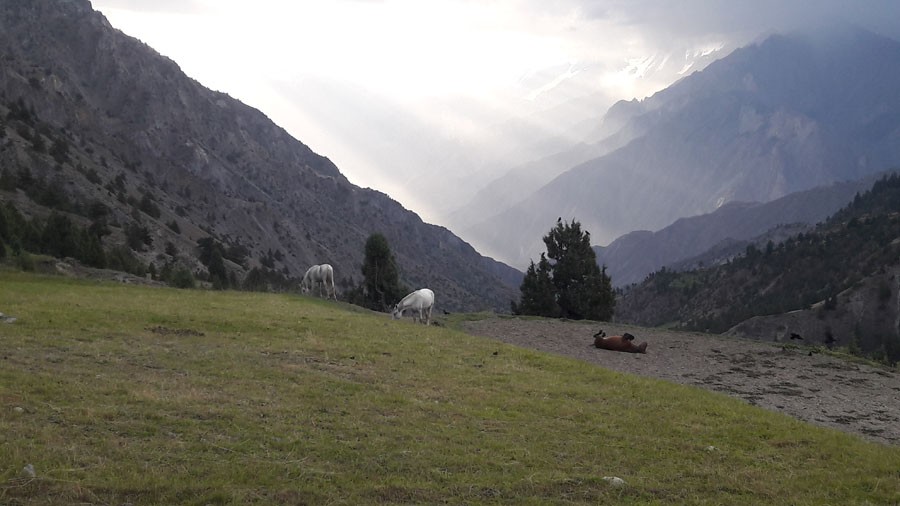
Off the beaten path, to Chaprote in Gilgit-Baltistan, where the bone-dry mountains of Karakoram whisper serenity

The quiet settlement of Chaprote is tucked in the bone-dry mountains of Karakoram. From the top, the mountains look like a rumpled quilt, and on the ground, they form a security blanket around the valley that prevent you from looking very far in any direction. The mountains not only isolate this farming village of Chaprote from the rest of the area but also whisper serenity.
Back in 2017, a friend and I were reading and watching documentaries on the tourist potential of Gilgit-Baltistan when Chaprote popped up, and within the next 24 hours, we were on our way there. I often stumble upon such places away from tourist trails. Even a slight mention can put a place on my mental map and it doesn’t leave me alone till I get there.
Located at a distance of 70 kilometres from Gilgit, across the Hunza river along the Karakoram Highway (KKH), the valley is situated 2134m above sea level. This serene valley, dubbed the ‘valley of protection’ by locals, once served as the throne of power from where the affairs of the princely state of Nagar were run. Once the state of Nagar was able to smooth its relations with the neighbouring warring states, the capital was shifted to Chalt but the valley did maintain its position in the political economy of the region. It played a pivotal role in harbouring revolutionaries who revolted against the king of Nagar post-1947. Today, the glorious past of the inhabitants of Chaprote have become a part of the folklore.
However, with the recent climatic calamities sweeping away the historical fort that once represented the past of the valley, Chaprote has now disappeared into oblivion.
While travelling on the KKH, we crossed over to Chalt and took the backcountry road to Chaprote. The long winding road through the valleys of Chalt and Rabaat suddenly ended, and we came to a jolting halt. Our driver couldn’t push the car any forward on loose gravel.
The end of the road also marked the beginning of the village precincts, and we found ourselves smacked in the centre of the village square. Immediately we started our search for a convenient place to stay, a hotel or a resthouse. At a distance, a group of men, seated in a corner, keeping a watchful eye on the comings and goings of the village square, saw us and inquired about our whereabouts. After a short introduction, we were welcomed into the village.
With no hotels, restaurants or even a kiosk in sight, we were asked to stay at the village numbardaar’s house, a gesture indicating our presence in the area as guests of the village. Our insistence of pitching up our tents somewhere in the village was politely turned down.
In a further show of hospitality, immediate arrangements were made for us to travel to the Gapa valley, a summer settlement for shepherds, located at the distance of about three to four hours from Chaprote. A few jeeps ply between Gapa and Chaprote, so the numbardaar made arrangements for us to travel before nightfall.
On a rough trail through mulberry, peach, apple and walnut orchards, we reached Gapa meadows in time to see the sunset with the best views of the Rakaposhi peak in the region. We found ourselves in an unexplored place where the grass was green and the horses ran wild in fields filled with a golden hazy.
As we gained altitude, people became more hospitable. A shepherd family invited us into their hut for a cup of evening tea and later for dinner. As we gathered around the fire in the small hut our hosts made us a local speciality gollay (saltish pancakes) that is served only on special occasions.
All throughout our stay, as we explored the valley and the surrounding glaciers and forests, the people of Chaprote demonstrated the characteristic kindness of the mountain people. Shepherd families gladly invited us for tea and meals and refused to accept payment for their kindness.
Indeed, time spent in nature is one of the oldest cures and a key reason why the valley remains untouched by the temptations of mass tourism. It’s pure. It’s not the people don’t want tourists in their area. They look forward to tourists who respect their way of life. Maybe this is the reason the village folks invited us to visit them again -- and breathe the fresh mountain air, drink fresh water from the mountain brooks and gaze upon limitless panoramas of mountain forest!